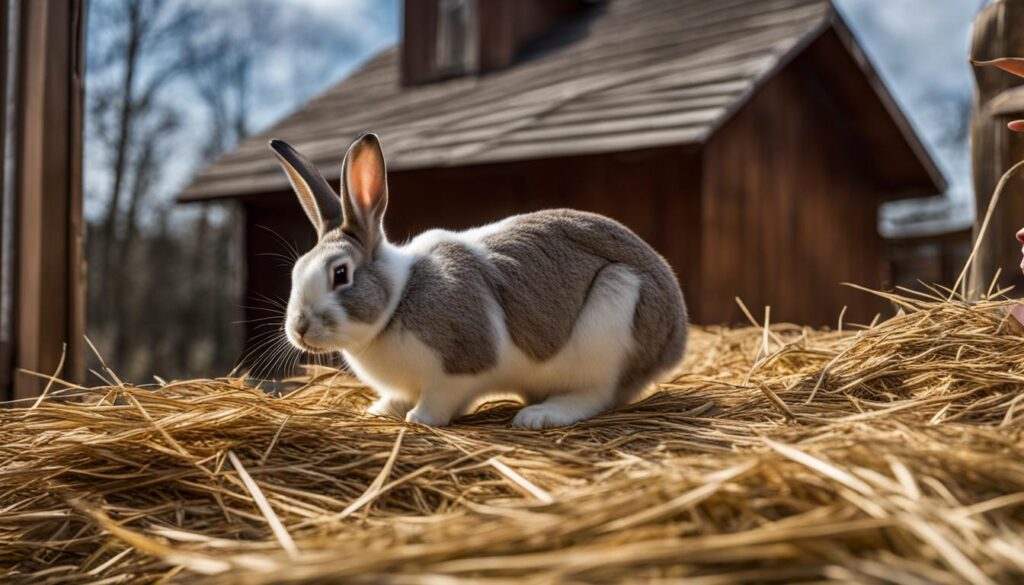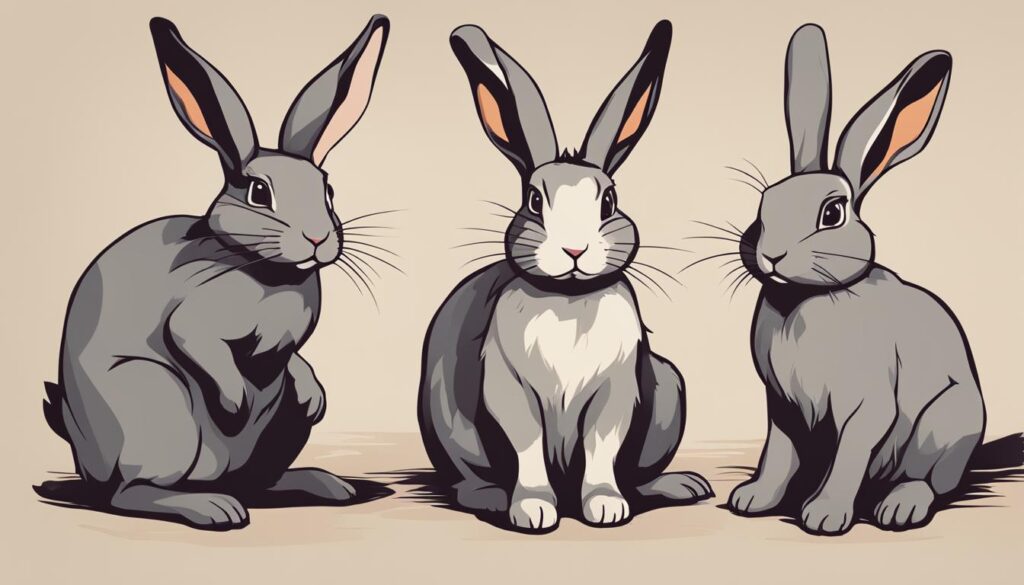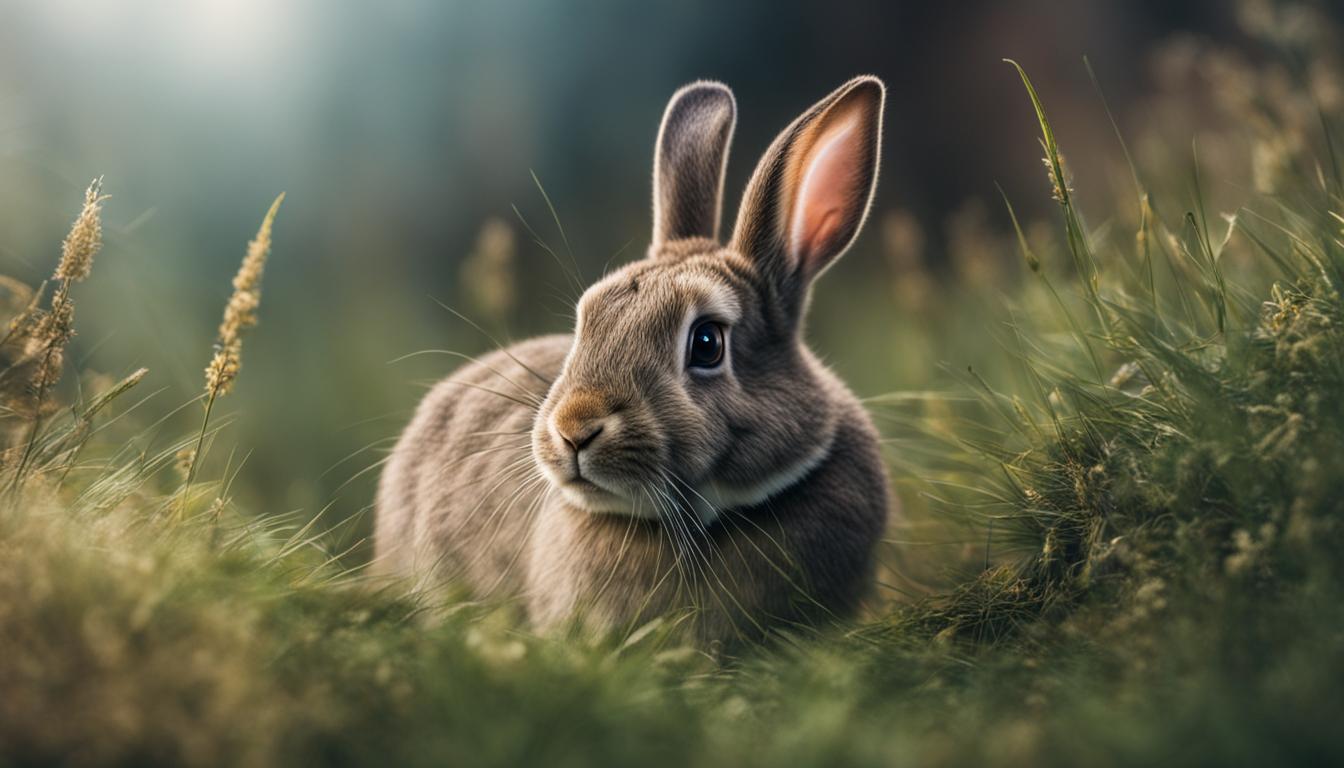Decoding Rabbit Communication: Understanding Your Pet’s Behavior
Rabbits are fascinating creatures with their own unique language consisting of vocalizations and body language signals. Understanding their communication is crucial for building a strong bond with your pet rabbit and providing appropriate care. In this article, we will explore the different types of rabbit sounds and body language cues, decipher their meanings, and learn how to respond to your bunny’s communication effectively.
Key Takeaways:
- By understanding rabbit communication, you can better meet their needs and build a strong bond.
- Rabbits communicate through vocalizations and body language cues.
- Types of rabbit sounds include honking, teeth grinding, thumping, screaming, and grunting.
- Rabbit body language cues include binkying, chinning, digging, flopping, kicking up feet, licking, nudging, and nipping.
- Observing and responding to your rabbit’s communication signals will enhance your bond and ensure their well-being.
Types of Rabbit Sounds: Bunny Basics
In the world of rabbits, communication goes beyond just body language. These adorable creatures have a unique way of vocalizing their emotions and needs. By understanding the different types of rabbit sounds, you can gain valuable insights into your bunny’s well-being and strengthen your bond with them.
Here are some common rabbit sounds and what they mean:
- Honking or buzzing noise: This happy and playful sound is often heard when your bunny is excited or content.
- Teeth grinding: Depending on the context, teeth grinding can indicate enjoyment or pain. Pay attention to their body language to determine the reason behind this behavior.
- Thumping: When a rabbit thumps their hind legs, it’s a warning signal to others. It typically signifies fear, frustration, or a perceived threat in their environment.
- Screaming: If your rabbit lets out a piercing scream, it’s a clear indication of extreme pain or fear. Immediate attention and care are required in such situations.
- Grunting or growling: When a rabbit grunts or growls, it’s a sign of anger or warning. They may exhibit this behavior when they feel threatened or protective of their space.
Understanding these rabbit sounds will help you better interpret your bunny’s emotions and needs. By paying attention to their vocalizations and observing their accompanying body language, you can respond effectively to their communication and provide the care they require.
Rabbit Sound Quotation:
“Rabbits have a unique way of communicating through vocalizations. By deciphering their sounds, you can understand their emotions and respond appropriately.” – Emily Johnson, Rabbit Behavior Specialist
Remember, every rabbit is unique, and their communication may vary. Spend time with your furry friend, listen to their sounds, and observe their behavior to develop a deeper understanding of their needs and preferences.

Next, let’s delve into the fascinating world of rabbit body language and discover how they communicate silently through their movements and gestures.
Rabbit Body Language: Silent Communicators
Rabbits have a unique way of communicating their emotions and needs through their body language. Understanding these non-verbal cues is crucial for interpreting your rabbit’s intentions and ensuring their well-being. In this section, we will explore various body language signals exhibited by rabbits and decipher their meanings.
Binkying: A Sign of Joy and Contentment
One of the most delightful behaviors of rabbits is binkying. Binkying is when a rabbit leaps into the air, twists their body, and kicks their feet. This joyful display communicates a sense of happiness and contentment. It is an expression of pure joy that you might witness when your rabbit is enjoying playtime or feeling particularly happy.
Chinning: Marking Territory and Affection
Chinning is a behavior where rabbits rub their chin on objects or even on their human companions. By doing this, rabbits release scent glands located in their chin, marking their territory and showing ownership. Chinning is not only a territorial behavior, but it can also be a sign of affection towards their owners.
Digging: A Request for Attention or Treats
When rabbits start digging on their owner’s legs or feet, it is often a way to seek attention or treats. This behavior is their way of communicating that they want your focus or desire a tasty reward. Providing them with the attention or treat they seek can reinforce their trust and strengthen the bond between you.
Flopping: Relaxation and Contentment
Rabbits have a habit of flopping onto their side, often with their legs stretched out, which indicates a state of relaxation and contentment. When your rabbit flops, it means they feel safe and secure in their environment. It’s a significant indication that they trust you and are comfortable enough to let their guard down.
Kicking Up Feet: Sign of Displeasure
When a rabbit kicks up their feet while hopping away, it is a sign of displeasure or frustration. This behavior typically occurs when they feel threatened or uncomfortable. It is essential to pay attention to the situation that triggered this response and address any potential stressors to ensure your rabbit’s well-being.
Licking: An Act of Affection and Bonding
Licking is a common behavior displayed by rabbits and is often interpreted as an act of affection. When your rabbit licks you, it signifies their trust and a desire to strengthen the bond between you. It is a gesture of love and companionship.
Nudging: Exploration and Communication
Rabbits frequently use nudging as a way to explore their surroundings and communicate their needs to their human companions. When your rabbit nudges you, it could mean they want attention, are seeking interaction, or are trying to direct your attention towards something of interest.
Nipping: Attention-Seeking or Dominance Signal
Occasionally, rabbits may nip lightly as a way to seek attention from their owners or assert dominance. It is crucial to understand the context and underlying motivation behind the nipping behavior. If your rabbit is nipping excessively or aggressively, it might require further observation and intervention to ensure a harmonious relationship.
By observing and understanding these various body language cues, you can better interpret your rabbit’s intentions and emotions. This knowledge will help you provide appropriate care, respond to their needs, and strengthen the bond between you and your furry companion.
Stay tuned for Section 4, where we will explore how observing rabbit behaviors and attuning to their needs can help you build a closer bond.
Building a Closer Bond: Observation and Attention
To build a strong bond with your rabbit, it is essential to observe their behaviors and pay attention to their needs and preferences. Rabbits, like humans, have unique personalities and individual preferences when it comes to food, toys, hiding spots, and social interactions. By regularly observing and attuning to your rabbit’s behaviors, you can establish patterns and understand their specific needs. This heightened awareness will not only strengthen your bond but also enhance your ability to communicate effectively with your pet rabbit.
One way to observe your rabbit’s behaviors is by spending quality time with them. Set aside dedicated bonding time each day to interact with your bunny. This can involve petting, grooming, or engaging in playtime activities. Pay attention to how your rabbit reacts to different stimuli and note their preferences. Some rabbits may enjoy a gentle head rub, while others may prefer being scratched behind the ears. By catering to their individual preferences, you’ll be able to create a positive and enjoyable experience for your furry friend.
Attuning to Your Rabbit’s Needs and Preferences
Attuning to your rabbit’s needs goes beyond understanding their behavior. It means providing them with an environment that aligns with their natural instincts and preferences. Consider the following factors:
- Food: Offer a varied diet that includes fresh hay, vegetables, and high-quality pellets. Observe which foods your rabbit enjoys the most and adjust their diet accordingly.
- Toys and Enrichment: Provide a variety of toys, such as chew toys and puzzle feeders, to keep your rabbit mentally stimulated. Pay attention to their interaction with each toy and remove any that may pose a safety risk.
- Hiding Spots: Rabbits are prey animals and seek secure hiding spots for relaxation and safety. Create cozy hideaways using blankets, boxes, or specialized bunny tents.
- Social Interaction: While rabbits may not be as social as dogs or cats, they still require positive social interactions. Observe how your rabbit responds to different types of interactions, whether they enjoy gentle petting or prefer independent playtime.

By considering these aspects and tailoring your rabbit’s environment to their preferences, you’ll create a space that promotes comfort and happiness, allowing for a closer bond between you and your pet.
“The more we observe and understand our rabbits, the better we can meet their unique needs, strengthening the bond between human and bunny.”
– Dr. Jane Doe, Rabbit Specialist
Observing rabbit behaviors and attuning to their needs requires patience and a genuine interest in connecting with your pet. Take the time to learn about rabbit body language and vocalizations, and always respect your rabbit’s boundaries. The more you practice observation and attention, the stronger and more fulfilling your bond with your rabbit will become.
| Rabbit Behavior | Meaning/Significance |
|---|---|
| Ear position: Ears up and alert | The rabbit is curious and interested in their surroundings |
| Ear position: Ears laid back | The rabbit is feeling threatened or fearful |
| Teeth grinding | Can indicate contentment or pain, context is important |
| Binkying (leaping into the air) | A sign of joy and contentment |
| Aggressive nudging | A sign that the rabbit wants attention or is seeking interaction |
Responding to Rabbit Communication: Enhancing the Bond
Responding to your rabbit’s communication signals is vital for enhancing your bond. Whether it’s acknowledging their vocalizations or interpreting their body language cues, understanding their needs and emotions will help you provide appropriate care. By responding appropriately to their communication, you can strengthen your bond and ensure your rabbit’s overall well-being.
When it comes to rabbit communication, it’s important to observe and listen to your furry friend. Pay attention to their signals, both verbal and non-verbal, as they provide valuable insights into their needs and emotions. Here are some key ways to respond to your rabbit’s communication:
1. Vocalizations
Rabbits use various vocalizations to express themselves. Pay attention to their sounds and try to decipher their meanings. Here are some common rabbit vocalizations:
| Vocalization | Meaning |
|---|---|
| Honking or buzzing noise | Excitement or happiness |
| Teeth grinding | Enjoyment or pain |
| Thumping | Warning signal, fear or frustration |
| Screaming | Extreme pain or fear, needs immediate attention |
| Grunting or growling | Anger or warning |
By understanding these vocalizations, you can better respond to your rabbit’s emotional needs.
2. Body Language
Rabbits also communicate through their body language. Pay attention to their posture, movements, and behaviors. Here are some important body language cues:
- Binking or leaping into the air – a sign of joy and contentment
- Chinning – marking territory, showing ownership and affection
- Digging on your legs or feet – seeking attention or treats
- Flopping onto their side – indicating relaxation and contentment
- Kicking up their feet while hopping away – signifying displeasure
- Licking – a sign of affection and bonding
- Nudging – exploring and communicating needs
- Nipping – seeking attention or asserting dominance
By paying close attention to your rabbit’s body language, you can better understand their intentions and respond accordingly.
3. Meeting their Needs
Understanding your rabbit’s communication is not just about interpretation but also about action. Responding to their needs is crucial for strengthening your bond. This includes providing the food they enjoy, offering toys that stimulate their natural instincts, and engaging in social interactions that they prefer.
Remember: Each rabbit is unique, and what works for one may not work for another. Take the time to observe and understand your rabbit’s preferences to create a customized care routine that strengthens your bond.

By responding to your rabbit’s communication signals and catering to their needs, you can enhance your bond and create a loving and fulfilling relationship with your furry companion.
Tips for Effective Rabbit Training and Socialization
Training and socializing your rabbit are crucial for their well-being and for strengthening your bond. To ensure successful training and socialization, it’s important to use positive reinforcement techniques, establish trust, and provide a stimulating environment for your bunny.
1. Positive Reinforcement Techniques
Positive reinforcement is a gentle and effective way to train your rabbit. Use treats, such as small pieces of their favorite fruits or vegetables, as rewards for desired behaviors. Praise and petting can also reinforce positive actions. Be patient and consistent in your training sessions, and always reward your rabbit’s efforts with positivity and encouragement.
2. Socializing with Gentle Introductions
Socializing your rabbit with other rabbits or humans is essential for their well-being and overall happiness. Start by introducing your rabbit to new environments and experiences gradually. Use gentle introductions and supervised interactions to ensure their safety and build their confidence. Allow them to explore and interact at their own pace, providing comfort and reassurance during the process.
3. Establishing Trust
Building trust is key to successful training and socialization. Spend quality time with your rabbit, engaging in activities they enjoy, such as gentle petting and playtime. Avoid forced interactions or actions that cause fear or stress. By showing them love, respect, and understanding, you’ll create a foundation of trust that will strengthen your bond and make training and socialization easier.
4. Creating a Stimulating Environment
Rabbits are intelligent and curious creatures who thrive in environments that provide mental and physical stimulation. Make sure your rabbit has plenty of toys, tunnels, and hiding spots to explore. Rotate their toys regularly to keep their interest piqued. Provide opportunities for exercise and exploration, such as supervised outdoor playtime in a secure area. A stimulating environment will keep your rabbit engaged, happy, and mentally stimulated.
| Benefits of Effective Training and Socialization | How It Helps Your Rabbit |
|---|---|
| Promotes behavioral development | Ensure a well-adjusted and happy bunny |
| Strengthens the bond between you and your rabbit | Promote trust and understanding |
| Reduces potential behavioral problems | Encourages positive behaviors and prevents destructive habits |
| Enhances your rabbit’s overall well-being | Creates a stimulating and fulfilling life for your bunny |
By following these tips for effective rabbit training and socialization, you’ll foster a strong bond with your bunny and ensure their well-being. Remember to be patient, consistent, and understanding as you work with your rabbit. With time and positive reinforcement, your furry friend will learn new behaviors and feel comfortable and confident in various situations.
Conclusion
Understanding rabbit communication is crucial for providing optimal care and building a strong bond with your pet rabbit. By decoding their sounds and body language, observing their behaviors, and responding appropriately, you can effectively communicate with your bunny and meet their needs. Training and socializing your rabbit will further enhance your bond and ensure their well-being.
Remember, each rabbit is unique, so take the time to get to know your rabbit’s individual behavior and preferences. By patiently and lovingly attending to their needs, you can develop a deep and rewarding relationship with your furry companion. Building a bond with your rabbit involves offering the right care, attention, and environment to support their physical and emotional well-being.
Keep in mind these rabbit care tips: provide a nourishing diet, a safe and stimulating habitat, and regular veterinary check-ups. Spend quality time bonding with your rabbit through play and affectionate interactions. With your understanding of bunny behavior and communication, you can give your rabbit the love and care they deserve, creating a happy and fulfilling life for both of you.
FAQ
What are the different types of rabbit sounds?
Rabbits communicate through various vocalizations, including honking, teeth grinding, thumping, screaming, and grunting.
How do rabbits communicate through their body language?
Rabbits use body language cues such as binkying, chinning, digging, flopping, kicking up their feet, licking, nudging, and nipping to communicate their emotions and needs.
How can I build a stronger bond with my rabbit?
To build a strong bond with your rabbit, it is important to observe their behaviors, pay attention to their needs and preferences, and provide appropriate care, including their preferred food, toys, and social interactions.
Why is responding to my rabbit’s communication signals important?
Responding to your rabbit’s communication signals is vital for enhancing your bond and ensuring their overall well-being. By understanding their needs and emotions and providing appropriate care, you strengthen your bond with your pet rabbit.
How can I train and socialize my rabbit?
Training and socializing your rabbit are important for their well-being and your bond. Positive reinforcement techniques such as treats and praise can help train your rabbit, and gentle introductions and supervised interactions with other rabbits or humans can help with socialization.
Why is understanding rabbit communication important in rabbit care?
Understanding rabbit communication is key to providing optimal care and building a strong bond with your pet rabbit. By deciphering their sounds and body language, observing their behaviors, and responding appropriately, you can effectively communicate with your bunny and meet their needs.


